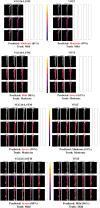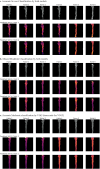Time-Dependent Deep Learning Prediction of Multiple Sclerosis Disability
- PMID: 38871944
- PMCID: PMC11612123
- DOI: 10.1007/s10278-024-01031-y
Time-Dependent Deep Learning Prediction of Multiple Sclerosis Disability
Abstract
The majority of deep learning models in medical image analysis concentrate on single snapshot timepoint circumstances, such as the identification of current pathology on a given image or volume. This is often in contrast to the diagnostic methodology in radiology where presumed pathologic findings are correlated to prior studies and subsequent changes over time. For multiple sclerosis (MS), the current body of literature describes various forms of lesion segmentation with few studies analyzing disability progression over time. For the purpose of longitudinal time-dependent analysis, we propose a combinatorial analysis of a video vision transformer (ViViT) benchmarked against traditional recurrent neural network of Convolutional Neural Network-Long Short-Term Memory (CNN-LSTM) architectures and a hybrid Vision Transformer-LSTM (ViT-LSTM) to predict long-term disability based upon the Extended Disability Severity Score (EDSS). The patient cohort was procured from a two-site institution with 703 patients' multisequence, contrast-enhanced MRIs of the cervical spine between the years 2002 and 2023. Following a competitive performance analysis, a VGG-16-based CNN-LSTM was compared to ViViT with an ablation analysis to determine time-dependency of the models. The VGG16-LSTM predicted trinary classification of EDSS score in 6 years with 0.74 AUC versus the ViViT with 0.84 AUC (p-value < 0.001 per 5 × 2 cross-validation F-test) on an 80:20 hold-out testing split. However, the VGG16-LSTM outperformed ViViT when patients with only 2 years of MRIs (n = 94) (0.75 AUC versus 0.72 AUC, respectively). Exact EDSS classification was investigated for both models using both classification and regression strategies but showed collectively worse performance. Our experimental results demonstrate the ability of time-dependent deep learning models to predict disability in MS using trinary stratification of disability, mimicking clinical practice. Further work includes external validation and subsequent observational clinical trials.
Keywords: Artificial intelligence; Medical imaging; Multiple sclerosis; Time-dependent deep learning; Video transformers.
© 2024. The Author(s) under exclusive licence to Society for Imaging Informatics in Medicine.
Conflict of interest statement
Declarations. Ethics Approval: This study was retrospective and did not involve change to treatment plans, additional radiation doses through increased diagnostic examinations, or release of patient information. The USF IRB committee approved a waiver and confirmed no ethical approval would be required. Consent to Participate: Informed consent was waived per IRB as this was a retrospective study. Patients upon receiving any scan within the facility network sign a form stating their deidentified exams may be used for future research and teaching purposes. Consent for Publication: The authors affirm that informed consent was waived per the IRB for publication of the images in Fig. 4. Competing Interests: The authors declare no competing interests.
Figures











Similar articles
-
Predicting 5-Year EDSS in Multiple Sclerosis with LSTM Networks: A Deep Learning Approach to Disease Progression.J Clin Neurosci. 2025 Jun;136:111218. doi: 10.1016/j.jocn.2025.111218. Epub 2025 Apr 1. J Clin Neurosci. 2025. PMID: 40174549
-
Global and Regional Deep Learning Models for Multiple Sclerosis Stratification From MRI.J Magn Reson Imaging. 2024 Jul;60(1):258-267. doi: 10.1002/jmri.29046. Epub 2023 Oct 6. J Magn Reson Imaging. 2024. PMID: 37803817
-
Artificial intelligence to predict clinical disability in patients with multiple sclerosis using FLAIR MRI.Diagn Interv Imaging. 2020 Dec;101(12):795-802. doi: 10.1016/j.diii.2020.05.009. Epub 2020 Jul 7. Diagn Interv Imaging. 2020. PMID: 32651155
-
Do it the transformer way: A comprehensive review of brain and vision transformers for autism spectrum disorder diagnosis and classification.Comput Biol Med. 2023 Dec;167:107667. doi: 10.1016/j.compbiomed.2023.107667. Epub 2023 Nov 3. Comput Biol Med. 2023. PMID: 37939407 Review.
-
Hybrid CNN-LSTM for Predicting Diabetes: A Review.Curr Diabetes Rev. 2024;20(7):e201023222410. doi: 10.2174/0115733998261151230925062430. Curr Diabetes Rev. 2024. PMID: 37867273 Review.
References
-
- Rovira, Àlex, and Cristina Auger. “Beyond McDonald: updated perspectives on MRI diagnosis of multiple sclerosis.” Expert Review of Neurotherapeutics 21.8 (2021): 895–911. - PubMed
-
- Csepany, Tunde. “Diagnosis of multiple sclerosis: A review of the 2017 revisions of the McDonald criteria.” Ideggyogyaszati szemle 71.9–10 (2018): 321–329. - PubMed
-
- Smyrke N, Dunn N, Murley C, Mason D. Standardized mortality ratios in multiple sclerosis: Systematic review with meta‐analysis. Acta Neurologica Scandinavica. 2022 Mar;145(3):360-70. - PubMed
-
- Lycklama, Geert, et al. “Spinal-cord MRI in multiple sclerosis.” The Lancet Neurology 2.9 (2003): 555–562. - PubMed
MeSH terms
LinkOut - more resources
Full Text Sources
Medical
